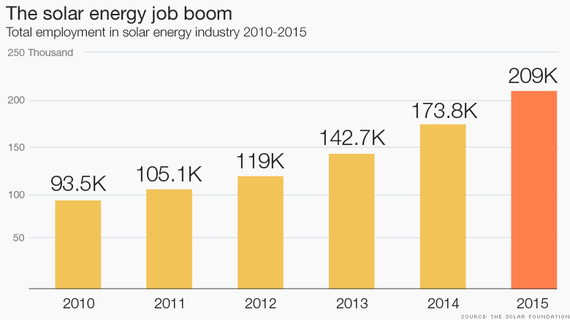When it comes to issues the American people agree on, few have as much support as solar and wind power. Three of every four of us adults, when asked about "solving the nation's energy problems," prefer solar and wind energy over fossil fuels. That is the highest level of public support for renewable energy in many years, perhaps ever.
This result, in a March poll by Gallup, raises some important questions in this election year.
For example, what on earth are the other 25 percent of us thinking? Cleaner air, the ability to choose and produce our own energy, savings on our energy bills: What's not to like?
Some elected officials and candidates for public office assume that voters care very little about clean energy or the closely related topic of global climate change. They may get that impression from the polls in which voters are asked to rank the national issues most important to them. Renewable energy and climate change are nearly always at the bottom of the list. The economy, jobs and national security usually are at the top.
But the type of energy we use has a lot to do with the stability of the economy, job creation, national security, public health and other top-ranked topics. The polls may separate these topics, but real life does not. If you care about jobs, the economy, public health and so on, you have to care about climate change.
The big question is whether we in the 75 percent group (more precisely, 73 percent) will vote this November for the candidates who agree that we need a clean energy economy, and against those who don't. There has never been a more important time to make that decision. In fact, 2016 should go down as the year of the Solar Energy Revolution. Here are a few of the reasons why:
The inflection point: This is a remarkable moment in the history of our country and, in fact, the history of nations. We have come to the point where we must reinvent how human progress is powered. In the United States and other industrialized nations, our job is not to repair the old energy infrastructure. Our job is to retool our infrastructure to support a clean energy economy. We should build to serve the future, not the past.
There is ample evidence that a moment of opportunity -- what DOE calls an "inflection point" -- has arrived. The need to minimize the enormous risks of climate change is at the top of the list. Most Americans get that now, regardless of their politics. Even if you are a skeptic, carbon-free energy is a way to hedge against the risk that you are wrong and the rest of us are right.
Second, the electric system is in need of major investments, by some estimates in the trillions of dollars. The system we built in the last century has been called the envy of the world, the "greatest engineering achievement of the 20th century" and the world's largest interconnected machine. It is indeed remarkable. It provides universal access to modern electricity for 148 million customers over 7 million miles of wires crisscrossing 3.5 million square miles of land area in the U.S.
But like all machines over time, the power system is aging. As Bloomberg News puts it, the power grid is "hulking, creaky and challenged by solar." And the 3,200 utilities that operate the grid "haven't changed their business strategy since Thomas Edison switched on the first power plant in 1882."
The U.S. Department of Energy agrees, saying the system is "aging, inefficient, congested and incapable of meeting the future energy needs of the information economy without significant operational changes and substantial public-private capital investment."
If we spend that money to repair and expand the old infrastructure for fossil fuels, we are either committing to another half-century of carbon emissions or we are setting the stage for billions of dollars of stranded investments as the solar revolution takes over. Neither is a good outcome.
Third, the old electric system is not just aging; it's also getting expensive. We should be embarrassed that the United States, the largest economy in the world, experiences more power outages than any other developed nation. Interruptions of electric service cost U.S. businesses as much as $150 billion annually. Outages caused by bad weather alone cost the economy as much as $70 billion annually, according to the Congressional Research Service.
Fourth, the energy system on which our economy relies is vulnerable not only to bad weather, but also to sabotage, cyber-attacks and poor maintenance. It's not widely publicized, but the Department of Homeland Security says our power grid is hacked or physically attacked an average of once every four days. Some of the significant blackouts in recent years have even been caused by untrimmed tree branches.
Fifth, the old energy system is causing other problems. The thermoelectric power plants that generate 90 percent of our electricity put greater demands on our fresh water resources than any other sector including agriculture. That already is a liability, but it will become an even greater problem as climate change affects fresh water supplies.
Innovation. The good news is that a global solar revolution already is underway. Worldwide clean energy investments broke records last year and are on pace to set new records this year. Twice as much money is being invested in clean energy as in fossil fuels, according to Bloomberg.
Government subsidies have helped, but fossil fuels have been subsidized, too. The real boost to solar is the economies of scale that have allowed its price to drop to 1/150th of what it was in the 1970s, Bloomberg explains. In just the last 16 years, the amount of solar power installed worldwide has doubled seven times.
This is not a short-lived fad. Consumers want to generate their own power. "Once consumers get a taste for their solar panels and learn about producing their own energy, they don't want laws or regulations that will take that away from them," CITYLAB blogger Julian Spector notes.
In addition, renewable energy has an inherent advantage over fossil fuels. "The reason solar-power generation will increasingly dominate," Bloomberg says, "(is that) it's a technology, not a fuel. As such, efficiency increases and prices fall as time goes on."
Jobs and the economy: Solar energy is the one of the fastest growing job-creating sectors in the economy today. The industry is growing 12 times faster than the overall economy, so rapidly that solar companies are having a hard time finding enough workers. In addition, solar and wind energy are spawning innovation in other technologies and energy systems including micro-grids, village power, energy storage, smart meters and so on.
Innovation also is taking place in clean energy finance. The marketplace has responded to the popularity of rooftop solar systems with new financing arrangements that allow homeowners and businesses to lease the systems with no upfront costs. That is making self-produced clean energy, once considered affordable only for the 1 percent, accessible to more of the 99 percent.
Meantime, warnings that introducing renewable energy to the grid would cause major increases in energy bills have proved wrong. All in all, the result is that the number of homes with solar on their roofs is growing from 30,000 in 2006 to as many as 3.8 million roofs four years from now, according to the industry's projections.
Whatever each person's motive is for becoming an independent solar power producer, the decision challenges a century old paradigm of central power production, as well as the future of very powerful fossil energy industries.
The solar revolution is not without opposition, however. The American Legislative Exchange Council (ALEC), a conservative organization with a membership of more than 2,000 state legislators, corporations and foundations, has conducted a campaign to repeal or roll back favorable utility rates and state renewable energy requirements. At one point in 2013, Renewable Energy Portfolio Standards (RPSs) were under attack in 22 of the states that have them. Some states are rolling back or rethinking net metering, a policy that pays solar customers retail rates for the energy they add to the grid. The changes can make rooftop solar less affordable and less financeable.
The November election. For the solar revolution to continue, it is important to elect solar revolutionaries to the White House and Congress. But it is even more important to elect them to state and local governments. That is where most of the legal authorities reside for making the transition to clean energy.
A key example has to do with public utility commissions (PUCs). Every state has one. Their job is to regulate electric utilities. Governors appoint PUC members in all but 12 states; PUC commissioners are elected by voters in 11 states and chosen by the legislature in one state. The people who regulate electric utilities, in other words, typically reflect the politics of the people who appoint or elect them.
The bottom line is pretty simple: We need to elect people who are on the right side of history because they are on the right side of now. We need renewable energy revolutionaries to be in the majority in city halls, legislative chambers and governors' offices as well as in Congress and the White House.
That's what we can attain if all of the Americans who say they prefer renewable energy and want action to curb climate change vote in line with those convictions this November.
Image Credits: The Solar Foundation produced the graph on solar job growth.

